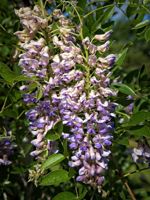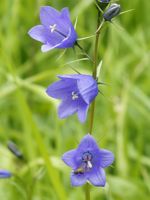Mon-Fri 9am - 5pm Mountain time
Blue Moon Wisteria vs Harebell
Wisteria macrostachya Blue Moon
Campanula rotundifolia
NOT AVAILABLE THIS SEASON - MIGHT RETURN
Blue Moon Wisteria is a striking, flowering vine, and the hardiest of the wisterias. Up to three times in one growing season you can expect showy, fragrant, lavender-blue flowers.
Make sure you plan your site as this vine requires a structure to support its mature weight. Try planting close to a post, trellis, or fence.
Harebell is a native perennial wildflower known for its bell-shaped, blue-violet flowers. The noddling blooms occur in clusters at the top of slender stems. Blooming in bursts from summer to fall, the flowers attract pollinators such as butterflies, bees, and hummingbirds.
Regular deadheading encourages additional blooms, extending its floral display through the season. Harebell prefers areas with cooler summer climates and does poorly in those that get too hot and humid. It is well suited for native wildflower gardens, pollinator gardens, and naturalization projects.
Blue Moon Wisteria Quick Facts
Harebell Quick Facts
Toxicity: can be toxic to cats, dogs, and horses when consumed

